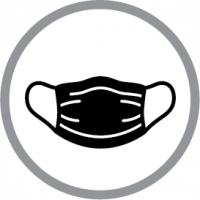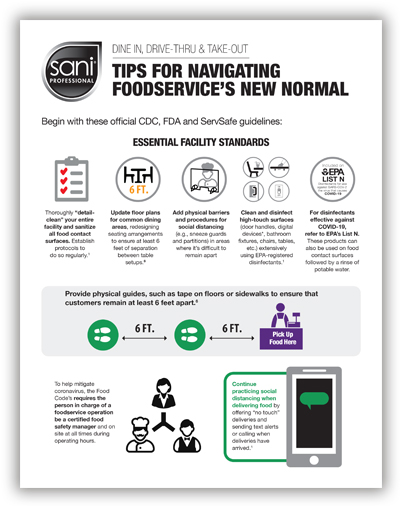Nationwide, COVID-19 has forced foodservice operators and their customers to change the way they interact and do business. Both groups have found ways to adapt to the so-called “new normal.”
82%
of Americans say they know which precautions to take and how to stay safe from COVID exposure.1
60%
say COVID safety
precautions have become
second nature.1
Data indicates that some of the precautions and trends forced upon the industry by the pandemic will likely be permanent. According to a Datassential study of restaurant goers, consumers, generally believe that safe dining environments are possible and that foodservice operations are doing a good job addressing health and safety issues. However, very real public health concerns remain – 94% said they have some level of concern about the risk of exposure to COVID-19 in restaurant settings with many of them indicating a vaccine would need to be widely available before things would truly feel “normal” again.2 This emphasizes the extent to which making consumers feel comfortable and safe is essential for foodservice operators.
Of those consumers still patronizing restaurants, there is a clear preference for drive-thru service and takeout. 62% believed ordering ahead and picking up to be the safest option. Online ordering, whether via website or app, is a must. What's more, diners say they'll likely continue to utilize online ordering, drive thrus, and third party ordering apps with contactless delivery even when COVID-19 is no longer a public health issue. Survey data shows a clear anticipated net decrease for both on-premise dining and on-site counter orders in the future.2
For all the uncertainty brought on by the pandemic, one thing is clear: Safety is the real “new normal.” COVID-19 may have permanently changed how consumers feel about their personal safety in dining environments. Moving forward it will be imperative that foodservice operators make their patrons feel SAFE. When asked what their priority will be – even after Coronavirus restrictions are lifted – safety topped all other factors including sustainability, restaurant preference, healthy menus, affordability, food quality and taste.2 Going above and beyond to make your customers feel safe will be more important than ever before.
Top 3 Safety Measures According to Consumers2

Foodservice workers
wore gloves

Foodservice workers
wore masks

Contactless
payment option
In addition to these precautions, cleanliness remains a primary factor weighed by consumers when making dining decisions. Consumers want common areas (especially bathrooms) to be thoroughly and regularly sanitized and disinfected. Along with mask wearing and table spacing, seeing common areas visibly wiped down regularly was ranked by consumers in the Top 3 restaurant attributes contributing to a sense of safety.2
Lastly, clear communication about what safety measures foodservice operators are taking in order to protect patrons and employees is also important. Survey data showed knowing this type of information was more important to consumers even than sales promotions. Overwhelmingly, consumers want to hear from restaurants via email, your website and social media feeds. Get the word out and use the safety precautions you are taking to set your operation apart from competitors.2
To protect employees and patrons alike, the use of disinfecting products effective against SARS-CoV-2 is essential. As a best practice measure to help prevent the spread of COVID-19 in community settings, the Centers for Disease Control and Prevention (CDC) and other health agencies continue to recommend cleaning and disinfecting frequently touched surfaces at least daily, or as required by food safety requirements3, using products listed on EPA’s List N: Disinfectants for Use Against SARS-CoV-2. List N includes Sani Professional Disinfecting Multi-Surface Wipes.
Additionally, 3rd party laboratory test results show that Sani Professional’s No-Rinse Sanitizing Multi-Surface Wipes also have demonstrated effectiveness, and are currently being evaluated by the EPA for inclusion on List N.
Sources
- https://datassential.com/wp-content/uploads/2020/06/Datassential-Coronavirus26-06-19-20-1.pdf
- Datassential, “One Table: Consumer Insights and the Path Forward,” May 2020
- https://www.cdc.gov/coronavirus/2019-ncov/community/organizations/business-employers/bars-restaurants.html


